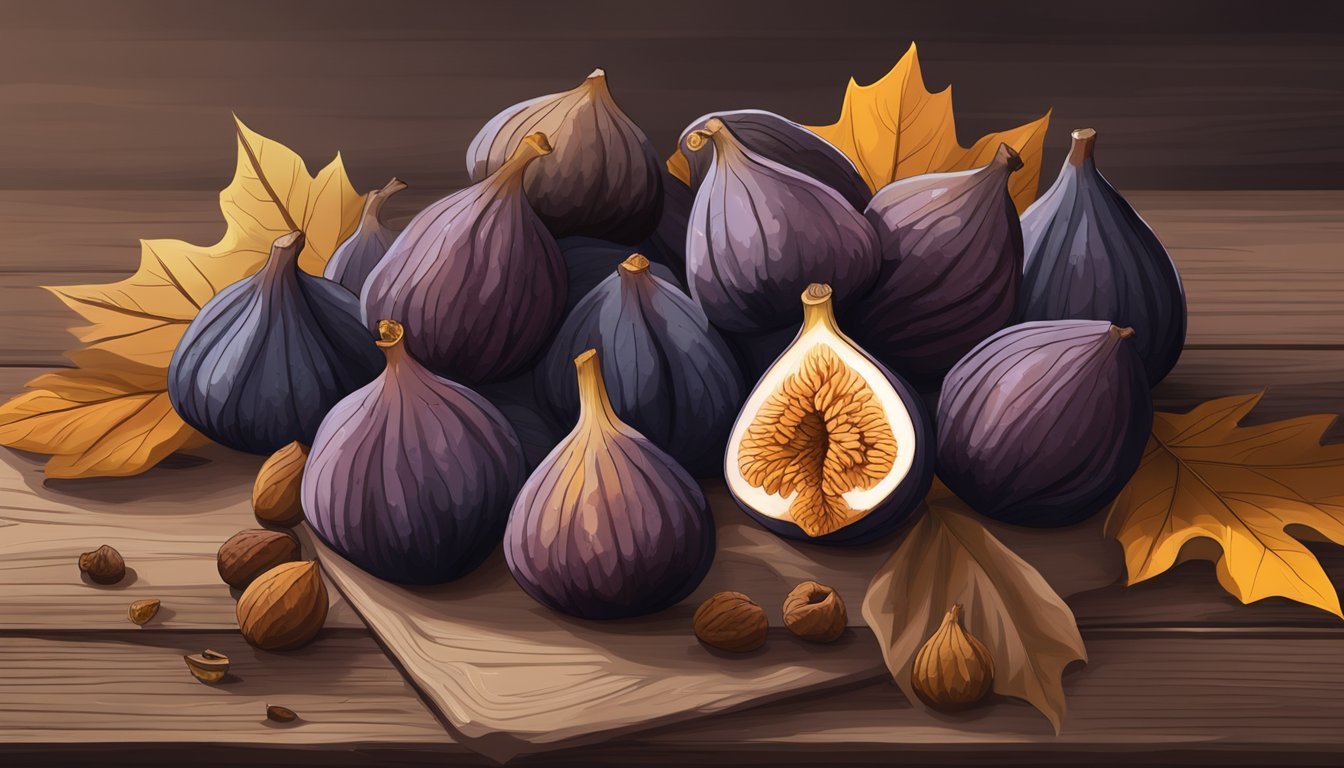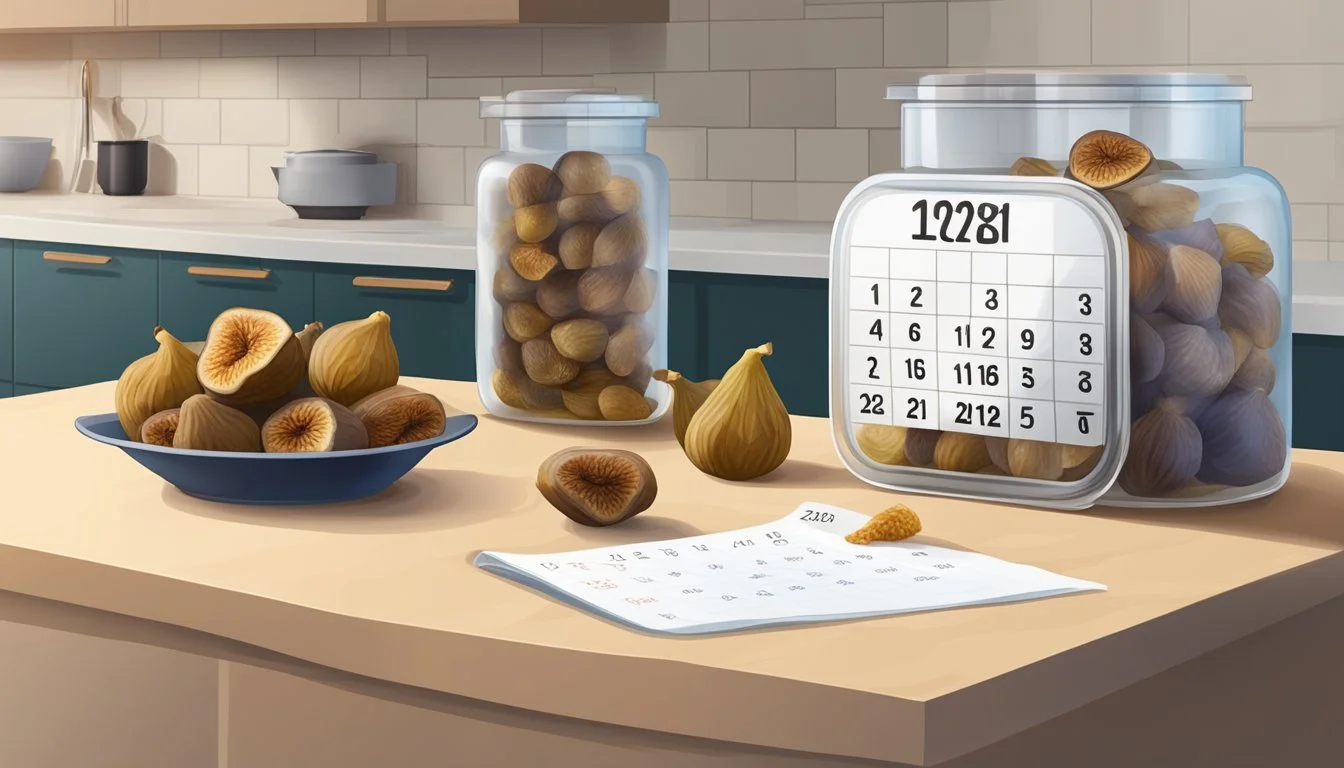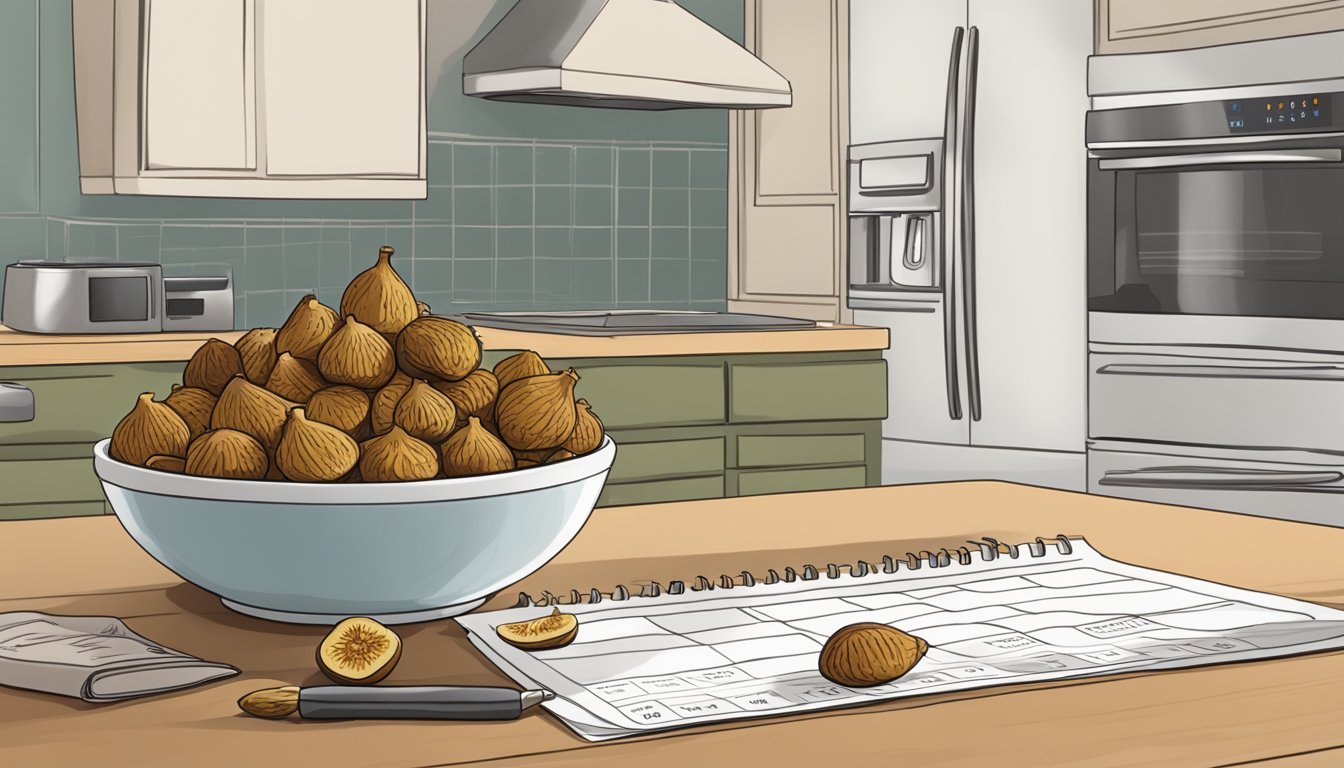How Long Do Dried Figs Last?
Shelf Life and Storage Tips
Dried figs (how long do dried figs last?) are a popular snack and culinary ingredient known for their natural sweetness and nutritional value. They boast a longer shelf life compared to their fresh counterparts, making them a convenient and versatile option for consumers. Proper storage plays a critical role in extending the life span of dried figs and maintaining their quality. When kept in ideal conditions, dried figs can last anywhere from four months to a year.
As a shelf-stable fruit, the longevity of dried figs largely depends on the environment in which they are stored. A cool, dry, and dark location, such as a pantry or a kitchen cabinet, is optimal. In such conditions, the absence of excessive moisture and direct sunlight helps to prevent spoilage. Moreover, after opening, transferring dried figs to sealed jars or airtight containers can further preserve their freshness and flavor.
Quality preservation is also an essential aspect of dried fig storage. Consistency in temperature and humidity levels ensures that dried figs retain their palatableness. Excessive air moisture or temperature fluctuations can adversely affect the figs, leading to potential spoilage. Vigilance in storage practices extends the edible life of dried figs, allowing them to be enjoyed in various culinary applications over time.
Understanding Dried Figs
Dried figs are a nutrient-dense snack offering a sweet taste, diverse sizes, and a unique drying method resulting in a long shelf life. This section explores their nutritional makeup, drying technique, variation in types, differences from their fresh counterpart, and their health advantages.
Nutritional Profile
Dried figs are a rich source of dietary fiber, essential vitamins, and minerals. They provide a concentrated dose of antioxidants. Each serving of dried figs typically contains:
Fiber: Aids in digestion and may help prevent constipation.
Vitamins: Include vitamin A, B vitamins, and vitamin K.
Minerals: Such as potassium, magnesium, zinc, and copper.
Antioxidants: Help combat oxidative stress in the body.
Their calorie content is higher than fresh figs due to the loss of water during the drying process, concentrating the nutrients.
Drying Process and Quality
The drying process affects the quality, texture, and color of dried figs. A meticulous process ensures:
Texture: A chewy exterior and a soft interior.
Color: Ranges from golden brown to dark brown.
The skin: Becomes wrinkled, a natural indicator of proper drying.
To retain a high nutritional value, the figs are dried slowly at controlled temperatures.
Varieties and Sizes
Dried figs come in various sizes and are sorted accordingly. Popular varieties include:
Calimyrna: Large and flavorsome with a greenish-yellow color.
Mission: Smaller, with a deep purple hue.
Turkish: Common, with a light brown skin often found in mixed dried fruit (how long does dried fruit last?) packs.
Different types can affect the texture and nutritional density.
Fresh vs. Dried Figs
The main difference between fresh and dried figs, aside from the moisture content, is the concentration of:
Calories: Higher in dried due to water loss.
Sugar: More concentrated in dried figs.
Nutrients: In dried figs, they are more densely packed.
Fresh figs offer a juicy, less sweet flavor, while dried ones provide a sweet, intense flavor and longer shelf life.
Health Benefits
Incorporating dried figs into the diet can contribute various health benefits, such as:
Digestive Health: The high fiber content can help alleviate constipation.
Nutritional Boost: A convenient and healthy snack packed with energy and nutrients.
Healthy Snack Option: Can satisfy sweet cravings with natural sugars and provide essential nutrients.
Consuming dried figs as part of a balanced diet can support overall health.
Proper Storage of Dried Figs
Ensuring dried figs last as long as possible hinges on maintaining optimal storage conditions. Proper storage not only extends their shelf life but also preserves their flavor and nutritional value.
Best Storage Conditions
The key to prolonging the freshness of dried figs lies in storing them in an environment that is cool, dry, and dark. Exposure to heat, moisture, or light can lead to spoilage. The ideal storage conditions for dried figs are:
Temperature: Below 70°F (21°C)
Humidity: Low, to prevent mold growth
Light: Minimal, preferably in a dark location
Pantry vs. Refrigerator vs. Freezer
Pantry: A pantry provides a suitable environment for short-term storage, up to four months, provided it is cool and not exposed to sunlight.
Refrigator: Refrigerated storage extends the shelf life of dried figs to six months or more. Ensure they are kept away from moisture.
Freezer: For the longest preservation, freezing is effective. Dried figs can be stored in the freezer, extending their shelf life to a year or beyond when using the correct container.
Container Types and Their Effectiveness
Choosing the right container is crucial for maintaining the quality of dried figs:
Glass Jars: A good choice for airtight storage, protecting against moisture and odors.
Plastic Containers: Must be of food-grade quality and preferably used with a tight-fitting lid.
Vacuum-Seal Bags: Excellent for removing air, which helps prevent freezer burn if frozen.
Zip-top Freezer Bags: A convenient option, though less effective than vacuum-sealed bags, double-bagging is recommended to reduce moisture exposure.
For all container options, ensuring an airtight seal is essential. Check seals periodically for effectiveness, especially if the figs are stored for an extended period.
Preservation and Shelf Life
Proper storage is crucial for maximizing the shelf life of dried figs while preserving their quality and flavor. Key practices include temperature control, light management, and maintaining optimal humidity levels.
Shelf Life Expectancy
Pantry: Dried figs can last for 6 months to 1 year when stored in a cool, dry, and dark place such as a pantry.
Refrigerator: If placed in an airtight container or sealed in a refrigerator, their shelf life can extend to 6-12 months.
Freezer: For long-term preservation, storing dried figs in a freezer bag or vacuum-sealed package can maintain their quality for 12-18 months.
Factors Affecting Preservation
Several factors influence the longevity and freshness of dried figs:
Temperature: Warmer conditions can shorten their shelf life, so a cool environment is preferable.
Light: Direct sunlight or bright indoor lighting can degrade quality; hence, storage in a dark location is advised.
Humidity: Excessive moisture accelerates spoilage. It is imperative to store dried figs in a place with low humidity.
Air Exposure: Oxygen can alter the taste and texture. Sealed containers are recommended to minimize air contact.
Extending Shelf Life
To extend the shelf life and maintain the quality of dried figs, one should:
Use airtight containers or sealable freezer bags to limit exposure to air and moisture.
Keep dried figs in a consistent and cool environment, such as the bottom shelf of a pantry.
Consider vacuum sealing for longer storage periods, especially if placing in a freezer to prevent freezer burn.
Identifying Spoilage
Recognizing when dried figs have gone bad is crucial to ensure they are safe for consumption and maintain their intended flavor profile.
Signs of Spoilage
Mold Growth: The presence of mold, indicated by fuzzy spots or discoloration, typically suggests spoilage. Odor: Any off or sour smells are strong indicators that the dried figs are no longer good.
Preventing Mold and Spoilage
To prevent spoilage, dried figs should be stored in a sealed container, kept away from direct light and maintained within a cool, dry, and dark place. Regulating humidity is key as moisture can accelerate mold growth.
Health Risks with Spoiled Figs
Consuming dried figs that show signs of spoilage may lead to illness. Spoiled foods often harbor foodborne pathogens or have byproducts from mold that can be harmful if ingested.
Salvaging and Rehydrating Dry Figs
If the dried figs have simply lost moisture but show no signs of spoilage, they can be rehydrated by soaking them in a liquid. This can soften the figs and restore some of their texture; however, it does not recover any lost nutritional value.
Culinary Uses of Dried Figs
Dried figs are a versatile ingredient known for their natural sweetness and chewy texture. They elevate a variety of recipes whether they are used as a primary flavor or a complementary ingredient.
Baking and Desserts
In the realm of baking, dried figs can be incorporated into numerous dessert options. Their high quality is maintained even after baking, providing a rich flavor and a pleasant texture in finished products. Figs make an excellent addition to:
Muffins: Chopped figs offer a sweet bite.
Cookies: Fine pieces provide chewiness.
For pastry items, diced dried figs ensure consistent distribution within the dough, enhancing each bite with their unique taste.
Snacks and Treats
Dried figs serve as a healthy snack on their own or can be combined with other ingredients for an energy-boosting treat. They are commonly found in:
Trail Mixes: Added for a touch of sweetness.
Energy Bars (how long do energy bars last?): Blended for texture variety.
They can be halved or diced, depending on the texture desired; their inherent stickiness also helps in binding other components when forming snack bars.
Rehydrating Techniques for Cooking
To soften and rehydrate dried figs for culinary uses such as compotes or to be added into savory dishes, follow these methods:
Soaking: Submerge in warm water for several hours.
Simmering: Gently cook in liquid to expedite softening.
Rehydration enhances their natural sweetness and makes them plump, thus improving both their texture and ability to blend seamlessly into the recipe.
Frequently Asked Questions
In this section, we address some common queries related to the storage methods, the impact of those methods on the longevity and freshness of dried figs, and how to handle typical storage issues.
Storage Methods Comparison
Storage Location Expected Shelf Life Notes Pantry or Kitchen Cabinet 6 months to 1 year Keep in a cool, dry place away from sunlight. Refrigerator Up to 1 year Useful for extending shelf life once the package is opened. Freezer 12-18 months Suitable for long-term storage, but be cautious of freezer burn.
For optimal quality, it is recommended to store dried figs in airtight containers or heavy-duty plastic bags. Glass jars with sealed lids can also be an effective option to minimize exposure to air and humidity, which are significant factors that can compromise the shelf life and quality of dried figs.
Impact on Longevity and Freshness
To maintain the freshness and longevity of dried figs, it's essential to understand the importance of storage conditions. Dried figs benefit from low moisture and darkness, which help prevent mold growth and preserve quality. Containers should remain airtight to keep out unwanted moisture and odors. If opening the packet frequently, consider transferring the figs into a smaller container to reduce air exposure and preserve freshness.
Dealing with Common Storage Issues
Issue Prevention Mold Growth Ensures storage in a dry environment and checks figs regularly. Humidity Impact Use desiccants or keep in airtight containers to manage humidity levels. Expiration Uncertainty Mark the date of storage and keep track of the figs' condition over time.
When faced with common storage problems like mold, take swift action. Discarding affected figs is a must due to potential health risks. If humidity is high, using desiccants can help absorb excess moisture. Always ensure bags or containers are properly sealed and durable to avoid rips or tears that can expose the figs to air and contaminants.
Final Thoughts
When it comes to preserving dried figs, storage plays a pivotal role in maintaining their quality and extending their longevity. These dehydrated fruits boast a prolonged shelf life due to their reduced moisture content and natural sugars, which act as preservatives. It is, however, critical to store them properly to ensure they retain their best quality.
Shelf Life:
Room Temperature: When kept in a cool, dry place, away from direct sunlight, dried figs can remain in good condition for 4 months to 1 year.
Refrigerator: Placing dried figs in airtight containers or sealed jars can extend this period slightly.
Freezer: For long-term storage, dried figs can last for 12-18 months in the freezer, although they don't keep indefinitely.
Storage Tips:
Keep them airtight: Use sealed jars or quality sealant bags to minimize exposure to air.
Maintain a cool environment: A pantry or cupboard can provide the ideal temperature and darkness.
Opt for refrigeration if the climate is warm or humid, as this can help preserve their high quality.
In summary, ripe figs, when dried, have an impressively long shelf life if they are stored efficiently, keeping them away from air, moisture, and extreme temperatures. By following these guidelines, consumers can enjoy the rich flavor and nutritional benefits of dried figs for many months.
References
The shelf life of dried figs varies depending on storage conditions. They are best kept in a cool, dry, and dark environment.
Move the Market asserts that stored properly, dried figs can last between 4 months to 1 year. Once opened, it advises to keep them in sealed jars or airtight containers.
Beezzly highlights that dried figs have become a popular delicacy and provides insight into storage and shelf life.
Oliver Griffin on December 1, 2023, mentions that while dried figs can go bad, proper storage gives them a longer shelf life than fresh figs. They benefit from their high sugar and low moisture content, aiding preservation.
An unspecified source indicates that at room temperature, dried figs can last for 6-12 months. In the fridge, this shelf life remains the same, and for extended preservation, storing them in the freezer is suggested.
This information collectively underscores the importance of airtight containers and proper storage environments to maximize the shelf life of dried figs.








